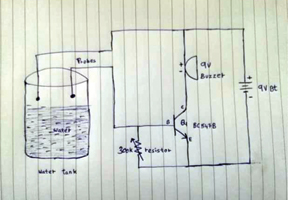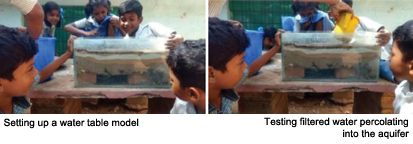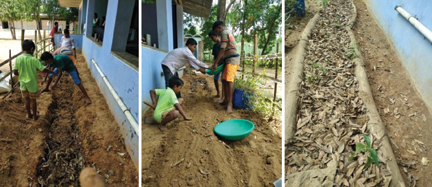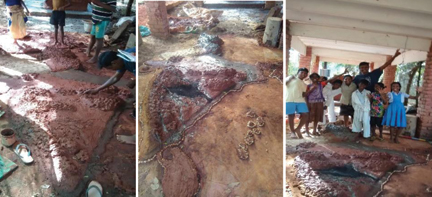Pratap G., Vasanth G., Ranjith P., Siva P., Ragu P., Sanjeev R.
Science and technology have significantly advanced in these modern times, and yet the world continues to grapple with many social issues. Technical advancement alone is insufficient for human and planetary well-being. The aim of education, therefore, is not only the advancement of scientific and critical thinking in children, but also their agency – to care deeply for the world and their ability to act on it. With this perspective, learning science should be done by engaging with life and the world around us. Children should be able to make an impact locally in their school and community and at the same time develop a broader perspective.
STEM Land works with over 300 rural children in and around Auroville on inculcating a sense of responsibility, equality and courage to create using technology. In this article we capture some of the engagements at the Isai Ambalam school where we work with around 80 children in bringing EVS, science and math alive. We will look at three themes – water, food and India and Indian democracy – that the children from 5th to 8th grade engaged with.
Water
A few years ago when there were hardly any rains in our area, the water table had gone down significantly and water shortage became a serious problem. Our students attempted to understand this problem and solve it.
Water depth measurements
To measure and document the groundwater level, 7th grade children built a small circuit with long cables and lowered it into the borewell to measure the depth of the water. The simple circuit comprised an LED and a battery and used the resistance of water for completing the circuit. While the process was physically cumbersome as the children had to put in and pull out the full length of the cable and measure the water level with tape, it introduced them to measurements in the context of the depth of our aquifer.
Avoiding tank overflow
Our 4th and 5th graders noticed that water was being wasted every time the overhead tank filled up to its capacity and water overflowed before someone noticed it and turned off the pump. Therefore, they decided to make a circuit with a buzzer to sound an alarm when the tank was full so that it could be turned off immediately.

The LED based water measurement was impractical, as waiting to see when the LED would turn on was as good as waiting by the tank to see that it was getting full. The students therefore felt that a buzzer that produced some kind of sound when the water reached the maximum level will be ideal. They modified the circuit and took care of the entire wiring from the tank to the pump switch. The thrill of waiting to see if this setup worked and the satisfaction that came over the students and teachers when we found that we had built a working device is inexplicable.
Even though the school finally adopted a professional water level controller, the children were the first to think and do something about it.
You can read more details about this project here: https://isaiambalamschool.wordpress.com/2017/07/22/water-level-indicator/

Groundwater model
As part of learning about the importance of water, the children decided to learn about groundwater. They built a model of the groundwater table using an aquarium. They placed three bricks inside to hold an iron mesh. They left space at the bottom for the aquifer. They put a layer of pebbles and layers of soil to get a sense of how the earth acts as a natural filter to collect fresh ground water in the aquifer.
They poured dirty water on top and observed how the different layers filter the water as it seeps through. They were thrilled to see water drops collecting at the bottom, which gave them some idea of groundwater, aquifer, and water collection.

You can read more details of this project here: https://www.auraauro.com/school/ground-water-model/
Food
Vegetable garden
The children wanted to find out if farming could be done with less water. They had studied about vegetables and wanted to grow a few on their own as well to see if they tasted better than the vegetables from the market.

To understand more about seeds, permaculture and irrigation methods, they visited the farms in Auroville. They learned about raised beds, mulching, irrigation, compost and indigenous seeds. They decided to execute permaculture in our school using raised beds and trenches. They created six raised beds. Each bed consisted of eight layers – grass, leaves, wood chips, straw, panchakaaviyam (a mixture of cow milk, urine, dung, curd and fermented ghee), two layers of topsoil, and charcoal that were of 15’x3’x2’ dimension. It took three hours per day to complete one raised bed. It took them five days to complete all six raised beds. They learnt to use materials available at hand to keep the beds together.
To be able to irrigate with less water, the children used a combination of drip irrigation and sprinklers. To grow saplings, they created a mother bed with seeds of tomato, brinjal and chilly.
For vegetables like cluster beans, flat beans, ladies’ finger, cow pea, etc., we directly sowed the seeds on the raised beds. Creepers were sown near the fence.
Harvesting
The children harvested the vegetables in four months and gave what they harvested to the kitchen in the school. The children even ate raw beans and relished its taste.
Read details of this project here: https://isaiambalamschool.wordpress.com/2018/01/27/vegetable-garden/
Medicinal garden
Following a session on Siddha medicine, the children made a medicinal garden to cure small illnesses and created an inventory of their own medicine. They used the waste water from the kitchen for this purpose. Each child selected one medicinal plant, researched its merits as well as the care it needed and documented it not only for themselves, but also for the younger students. They dug a bed of 1 foot by 32 feet. First they put sticks, then dry leaves. They added cow dung and mixed jaggery and applied it on the dry leaves. Then they covered it with sand. They repeated this process about eight times, then planted the medicinal plants on the bed and started the garden.

Read more details here: https://isaiambalamschool.wordpress.com/2018/08/28/medicinal-garden/
India and democracy
We found that a project on India and Indian democracy can bring up interesting design and science challenges and integrate various kinds of learning.
India map – education by design
The first challenge was to build a large topological three meter long map of India on the ground. The goal was to represent with some degree of precision not only the heights of plateaus and mountains, but also the kinds of soils found in different places in India.
Students from 6th and 7th grades made the India map using red soil, clay, bricks, pebbles, sand, alluvial soil, and black soil. Each student was given different parts of the country to draw. Using graph sheets to scale, they drew and built the map of India.

Students started the structure using clay, however, clay cracked as it dried up and would have been insufficient for such a large map so they decided to use red soil as the base. They used bricks and red soil for mountains. In order to differentiate between desert, mountains and rivers they used different materials. For the rivers they mixed cement with water and created many rivers in India. For the desert, they used sand. In the eastern parts of the country, they put alluvial soil since rivers here leave behind alluvial soil before joining the sea.
They identified and used different types of soil available in and around the school. They also co-related different soils, climate with vegetables, fruits and crops grown there. For example, students understood that the soil deposited in the deltas is called alluvial soil, which is rich in sediments and makes for a rich cultivation soil. The final map looked fabulous with details of mountains, rivers and other geographical features.
Read details here: https://isaiambalamschool.wordpress.com/2018/03/05/india-map/
National elections
During the national elections, the children took up learning about the houses in the parliament and how Indian democracy was organized. They also decided to organize a school election. They understood how the political process in their own villages is corrupted by various biases, cash, alcohol, etc. They dramatized these aspects for their parents and took steps, so that their homes are not influenced by these. Here, we focus on a small project of understanding and building their own EVM (Electronic Voting Machine).

The children presented what they learnt to the whole school during the assembly. They built a voting machine using a raspberry pi0 microprocessor. They built both the software as well as the corresponding hardware. They formed into three groups – two parties and one election commission. In the hardware control unit they had three options, one for each party and the third for NOTA (None Of The Above). The parties campaigned and talked to the voters (other children) to learn about what could be improved in the school. The children also built an app for the election controller, which would enable a voter entering the booth to cast only one vote. Each button only updated the corresponding count. Only the final counts were reported while recording when a person gave their vote for cross checking.
Read more details here: https://isaiambalamschool.wordpress.com/2019/03/23/electionebd-with-6th-7th-and-8th-graders/
Conclusion
In an effort to build agency in children we have documented some of the projects they did in Isai Ambalam School based on not only what they found interesting, but what impacted them and what they cared about. Such an approach to science and integrated learning, not only inculcates interest and scientific thinking, but also agency – caring and willingness to act on what we are deeply concerned about.
Sanjeev Ranganathan is the founder of C3STREAM Land Designs (C3SLD) and STEM Land, organizations that work with rural youth and children to further STEAM education along with cultivating their competencies on how to use skills to shift cultural and societal norms while developing their inner capacities of responsibility, equality and courage to create. He also runs the Isai Ambalam school. He can be reached at sanjeev.ranganathan@gmail.com.
Pratap Ganesan is a teacher and engineer at C3SLD. He is the STEM coordinator at Isai Ambalam school and works on hands-on projects with the children.
Vasantharaj Gandhi is a teacher and engineer at C3SLD. He supports STEM education at Isai Ambalam school.
Ranjith Perumal is a facilitator and engineer at C3SLD. He loves to work with children and youth and help them upskill in technology and guide them to find their inner potential and the divine within.
Siva Perumal is a facilitator and engineer. He has 20 years of teaching experience with youth and children. He loves exploring ways of creating different environments for children to find their inner potential.
Raghu Prashanth has been working on various research activities at Isai Ambalam School that make learning joyful.
